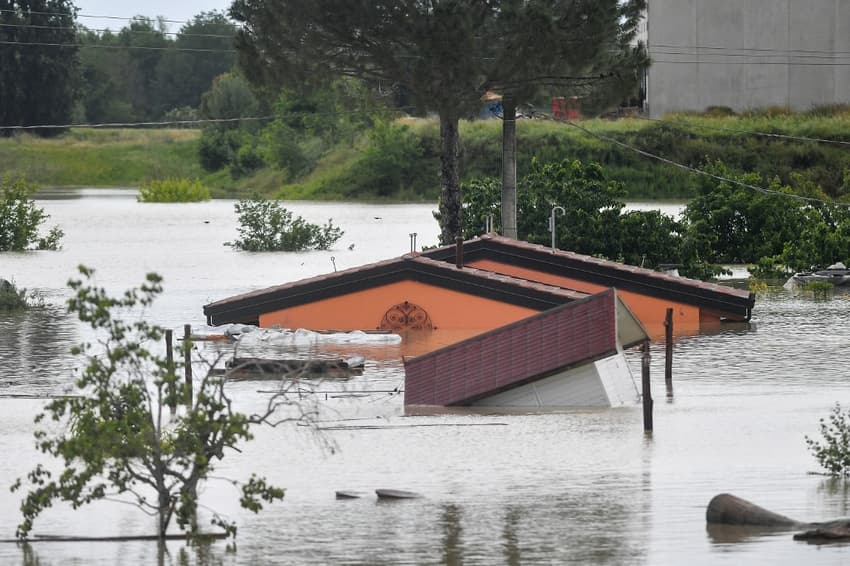MAPS: Which parts of Italy have been hit by flooding?

As a prolonged spell of stormy weather sweeps Italy, here's a look at which areas have been affected by severe flooding this week.
Severe flooding in Italy has made international headlines once again this week after at least 11 people were killed on Wednesday.
While most parts of Italy have experienced heavy rain and thunderstorms recently amid a prolonged spell of unusually bad May weather, the disastrous flooding this week affected one area of the country in particular.
The worst-affected areas were all in the north-eastern region of Emilia Romagna, which is home to the city of Bologna, while parts of the neighbouring regions of Marche and Tuscany were also hit by severe storms.
The map below shows the parts of Italy placed on the highest-level 'red' alert by public safety officials on Wednesday, most of which are in Emilia Romagna.
📅 Mercoledì #17maggio
🔔🔴 #allertaROSSA meteo-idro in Emilia-Romagna
🔔🟠 #allertaARANCIONE in Emilia-Romagna, Marche e Toscana
🔔🟡 #allertaGIALLA in 12 regioni
🔍 Consulta il bollettino nazionale per conoscere il livello e le zone di allerta 👉 https://t.co/mE6sFKPdqY pic.twitter.com/qgkUcq59ka
— Dipartimento Protezione Civile (@DPCgov) May 16, 2023
Large parts of the south and centre of the country were meanwhile placed on lower-level 'amber' or 'yellow' alerts, including the cities of Rome and Naples.
The confirmed deaths were all in Emilia Romagna, which had already suffered deadly floods earlier in May.
Intense rainfall this time was concentrated in the provinces of Forli, Cesena, and Ravenna, all of which are in the east of the region.
🔴#EMSR664
Nuova attivazione per il nostro #RapidMappingTeam
Una nuova ondata di mal tempo sta colpendo l'#EmiliaRomagna🇮🇹 e ci si aspettano nuovamente zone alluvionate e frane
Aggiornamenti 🔜
🔗https://t.co/rHNUhwluvd pic.twitter.com/iFc1zKueyi
— Copernicus EMS (@CopernicusEMS) May 17, 2023
Around 50 centimetres (20 inches) of rain fell within 36 hours in these areas - around half the normal annual rainfall, a situation officials said had "few precedents".
READ ALSO: No more 'dolce vita': How extreme weather could change Italian tourism forever
The below map from the Italian civil protection agency shows the parts of the region placed on red alert for flooding on Wednesday.
#AllertaMeteoER
Dalle 00:00 del 17/05/2023 alle 00:00 del 18/05/2023
ROSSA per criticità #idraulica e #idrogeologica;
ARANCIONE per criticità #idraulica e #idrogeologica;
GIALLA per criticità #idraulica #idrogeologica e #mareggiate
➡️ https://t.co/uOD9PN5UDq pic.twitter.com/p54Ud8pX8p
— allertameteoRER (@AllertaMeteoRER) May 16, 2023
All rivers in the region had broken their banks between Tuesday and Wednesday, with 36 local authorities reported flooding and 48 reporting landslides.
Emilia Romagna and many other parts of northern Italy suffered a severe drought this winter, on top of a record lack of rain last summer that devastated harvests.
The region was among the parts of Europe expected to be hit hardest by extreme weather events caused by climate change, according to an international study published in 2022.
Comments
See Also
Severe flooding in Italy has made international headlines once again this week after at least 11 people were killed on Wednesday.
While most parts of Italy have experienced heavy rain and thunderstorms recently amid a prolonged spell of unusually bad May weather, the disastrous flooding this week affected one area of the country in particular.
The worst-affected areas were all in the north-eastern region of Emilia Romagna, which is home to the city of Bologna, while parts of the neighbouring regions of Marche and Tuscany were also hit by severe storms.
The map below shows the parts of Italy placed on the highest-level 'red' alert by public safety officials on Wednesday, most of which are in Emilia Romagna.
📅 Mercoledì #17maggio
— Dipartimento Protezione Civile (@DPCgov) May 16, 2023
🔔🔴 #allertaROSSA meteo-idro in Emilia-Romagna
🔔🟠 #allertaARANCIONE in Emilia-Romagna, Marche e Toscana
🔔🟡 #allertaGIALLA in 12 regioni
🔍 Consulta il bollettino nazionale per conoscere il livello e le zone di allerta 👉 https://t.co/mE6sFKPdqY pic.twitter.com/qgkUcq59ka
Large parts of the south and centre of the country were meanwhile placed on lower-level 'amber' or 'yellow' alerts, including the cities of Rome and Naples.
The confirmed deaths were all in Emilia Romagna, which had already suffered deadly floods earlier in May.
Intense rainfall this time was concentrated in the provinces of Forli, Cesena, and Ravenna, all of which are in the east of the region.
🔴#EMSR664
— Copernicus EMS (@CopernicusEMS) May 17, 2023
Nuova attivazione per il nostro #RapidMappingTeam
Una nuova ondata di mal tempo sta colpendo l'#EmiliaRomagna🇮🇹 e ci si aspettano nuovamente zone alluvionate e frane
Aggiornamenti 🔜
🔗https://t.co/rHNUhwluvd pic.twitter.com/iFc1zKueyi
Around 50 centimetres (20 inches) of rain fell within 36 hours in these areas - around half the normal annual rainfall, a situation officials said had "few precedents".
READ ALSO: No more 'dolce vita': How extreme weather could change Italian tourism forever
The below map from the Italian civil protection agency shows the parts of the region placed on red alert for flooding on Wednesday.
#AllertaMeteoER
— allertameteoRER (@AllertaMeteoRER) May 16, 2023
Dalle 00:00 del 17/05/2023 alle 00:00 del 18/05/2023
ROSSA per criticità #idraulica e #idrogeologica;
ARANCIONE per criticità #idraulica e #idrogeologica;
GIALLA per criticità #idraulica #idrogeologica e #mareggiate
➡️ https://t.co/uOD9PN5UDq pic.twitter.com/p54Ud8pX8p
All rivers in the region had broken their banks between Tuesday and Wednesday, with 36 local authorities reported flooding and 48 reporting landslides.
Emilia Romagna and many other parts of northern Italy suffered a severe drought this winter, on top of a record lack of rain last summer that devastated harvests.
The region was among the parts of Europe expected to be hit hardest by extreme weather events caused by climate change, according to an international study published in 2022.
Join the conversation in our comments section below. Share your own views and experience and if you have a question or suggestion for our journalists then email us at [email protected].
Please keep comments civil, constructive and on topic – and make sure to read our terms of use before getting involved.
Please log in here to leave a comment.